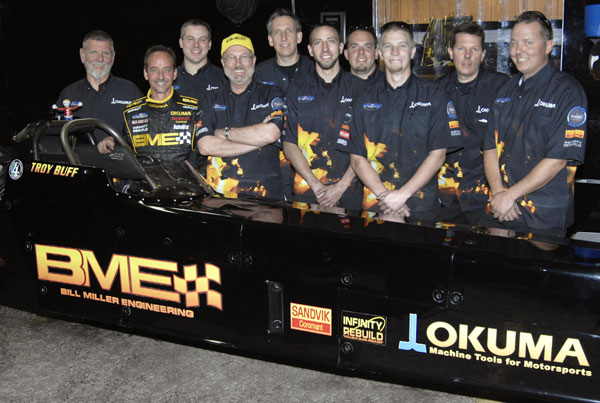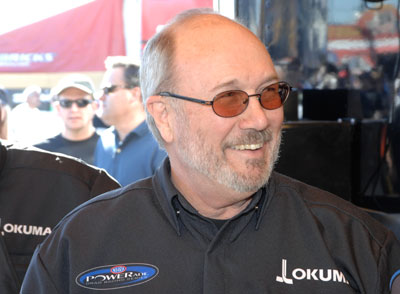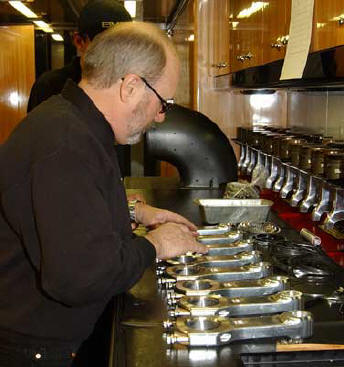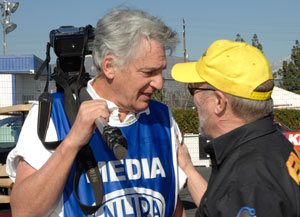BILL MILLER: WORK TO SUCCESS
 Would anyone ever believe the pistons inside that 8,000-horse Top Fuel
dragster were crafted by a man who once slept on the floor of his shop?
Would anyone ever believe the pistons inside that 8,000-horse Top Fuel
dragster were crafted by a man who once slept on the floor of his shop?Behind every successful man is a story that begs to be told.
Bill Miller rarely discusses the days he slumbered on an old shag carpet alongside his lathe. He’s a man of old-school networking where a man’s word is his contract and his sealing signature is his handshake.
Miller is in no way ashamed of the obscure factoid. He’s just a forward thinker who believes success isn’t achieved by looking in the rear view mirror.

Would anyone ever believe the pistons inside that 8,000-horse Top Fuel dragster were crafted by a man who once slept

on the floor of his shop?
Behind every successful man is a story that begs to be told.
Bill Miller rarely discusses the days he slumbered on an old shag
carpet alongside his lathe. He’s a man of old-school networking where a
man’s word is his contract and his sealing signature is his handshake.
Miller is in no way ashamed of the obscure factoid. He’s just a forward
thinker who believes success isn’t achieved by looking in the rear view
mirror.
One of his heroes is former U.S. President Calvin Coolidge. He pays
homage to the former leader with a sign that hangs in both his BME shop
in Carson City, Nev., and the race trailer that runs a limited schedule
on the NHRA tour.
“Nothing in the world can take the place of persistence, talent will
not because nothing is more common than unsuccessful men with talent.
Genius will not, unrewarded genius is almost a proverb. Education will
not, the world is full of educated derelicts. Persistence and
determination alone are omnipotent.”
It’s a Sunday afternoon on a holiday weekend and Miller labors away
improving on his product and seeking out details which will enable his
single-car, part-time Top Fuel dragster to compete against the
Goliaths. His company is one of the more successful suppliers in the
aftermarket industry yet he is driven to the point he toils away at
improving the product he provides.
“I can guarantee you that after 33 years, money-wise; I don’t need to
be here,” Miller added. “I’m here because I want to be, I’m here
because there are things I need to think about and do, that I can’t do
during the week. Not necessarily about a race car but just things in
general. If the sun comes up, go to work. If you want to stay home and
have a beer and watch TV, don’t bitch the next time you see someone
drive by in a Ferrari, because you’re not doing anything to try and
make the money to buy the Ferrari.
“Don’t envy the guy that you see has a lot of toys in his backyard, follow him around – do what he does. Learn from him.”
I Worked a Half-Day Today, That’s 12-Hours Kid … - Bill Miller
a d v e r t i s e m e n t
Click to visit our sponsor's website
 That
advice is not far removed from what the Navy veteran did several
decades ago. Fresh out of the military, he sought a niche in the
automotive industry.
That
advice is not far removed from what the Navy veteran did several
decades ago. Fresh out of the military, he sought a niche in the
automotive industry.
Miller crossed paths with a San Diego speed shop owner who recommended
him to a warehouse job which eventually went away thus opening a door
to begin working for a Mallory distributor in Southern California.
The general manager from the previous job called Miller shortly after he began his new job to offer a higher ranking position.
At this job, Miller handled the hot rod calls, which only accounted for about 15% of the company’s income.
The company, Ansen, was eventually bought out by a larger company who
buried the product line in their myriad of businesses. The company’s
value quickly deteriorated.
Ansen was sold to another businessman named Art Hale, then owner of
U.S. Mag Wheels, an aftermarket wheel manufacturer. Hale and Parnelli
Jones had enough money and to this day Miller still doesn’t understand
their reasoning for purchasing Ansen from the Whittaker Corporation.
Ever hear the saying that one man’s trash is another man’s treasure? This was certainly the case for Miller.
a d v e r t i s e m e n t
Click to visit our sponsor's website
Hale and his associates didn’t want the connecting rod portion of
the business which came along as part of the purchase. They wanted the
company for the wheel making capabilities.
That left the new owner with a tremendous stock of rods, 440 Wedge
connecting rods to be exact, with no real way to liquidate the
investment.
That’s when Miller felt he had nothing to lose and made a proposal to his bosses.
“You have to remember that I didn’t have any assets to my name at that
time,” Miller admitted. “I was single, living in Hermosa Beach, living
it up on my 200 dollar a week salary. I told Art, I said ‘Let me try
selling all this stuff for you. I said you’ve got nothing to lose, you
have a lot of inventory here and I know a lot of people. Let me see
what I can do to sell these connecting rods and pay you back your
$75,000 dollars.”
This was in 1973 and because Hale had nothing to lose, took Miller up on his offer.
“We moved all the machines, all the tooling, down to one of his shops
in Long Beach, California right next to the Wheel Manufacturing Plant
that was in Long Beach,” Miller said. “This building was 1,100 square
feet. I remember this because I could walk down once we got the
machines in there and put my hands out wide and hit the machines
walking through. From front to back it was only about 50 or 60 feet –
it wasn’t very deep.
“We moved all the forgings down there, all the machinery, anything that
had to do with the connecting rods. I started making connecting rods.”
Miller by his own admission was nothing more than a salesman without
enough experience to know how to turn on a bridgeport. In case you
aren’t keen on the names of machinery, a bridgeport is a vertical
milling machine.
a d v e r t i s e m e n t
Click to visit our sponsor's website
 “Here
I was working for Hale during the day selling wheels, working at night
turning these things into connecting rods,” Miller said. “I said I may
not be smarter than any of these guys but I’m sure as heck not dumber.
“Here
I was working for Hale during the day selling wheels, working at night
turning these things into connecting rods,” Miller said. “I said I may
not be smarter than any of these guys but I’m sure as heck not dumber.
“I would leave Art’s place in Gardena at about 5:00,” Miller explained.
“I would then drive down to Long Beach, open up the doors and finish
the manufacturing of those rods and then I ran ads in National Dragster
to sell them. Of course they were cheap, Art got half the money and I
got half the money. That went on for about a year and a half until it
finally got so bad that I just couldn’t get any sleep and I was really,
really tired.”
Miller maintained a brutal seven days a week schedule.
“I would work until about 2 AM when I would just get too tired and
couldn’t go home because it was better for me if I laid down and went
to sleep on the floor because I could gain 45 minutes of sleep,” Miller
admitted. “So in this building that Art had, he had an office in there,
it was 10 by 10 just enough to put a desk and a telephone in. It had
this horrible green shag carpet. This shag carpet, because I was in a
machine shop, had chips all over the place.”
That green shag carpet with a piece of cardboard became his bed on many nights.
Miller understood he could only maintain this pace for only so long
before he either burned out or dropped dead from overwhelming fatigue.
A year into this routine had worked perfectly for Miller as he’d
managed to pay back three-quarters of the $75,000 to Hale and even
saved $10,000 for himself. In the troubled economic times of the
mid-1970s, Miller found himself in a pretty good position.
Miller was single with no children and the ten grand was enough to sustain him for a year.
“I told myself one day, you got 10,000 bucks in the bank you’re either
going to make this work or you ain’t,” Miller recalled. “I asked
myself, “Can you make 10,000 a year making connecting rods? Yeah, I
probably can. The worst possible outcome is that I would have to go
find a job again.”
Miller went in the next day to tender his resignation to Hale.
The next Monday morning he went to work as his own boss was an eye opener.
“I’ll never forget waking up that next Monday morning knowing I don’t
have to go to work, I don’t have to do anything,” Miller admitted. “I
can sit here and screw around all day. I can go down to the beach and
try to pick up girls. Or I can just get off my tail and go to work,
which is what I chose to do. That started the seven days a week. I just
never quit doing it.”
That’s why when Miller walks into his office and sees that old green
shag carpet sitting in the corner of his office and the writings of
Calvin Coolidge, he gets inspired.
For Miller, each day is an inspiration.
| {loadposition feedback} |







































